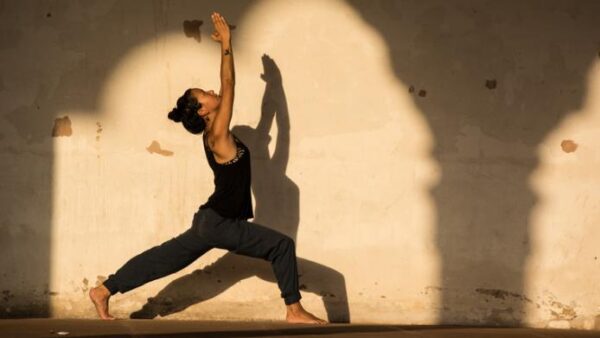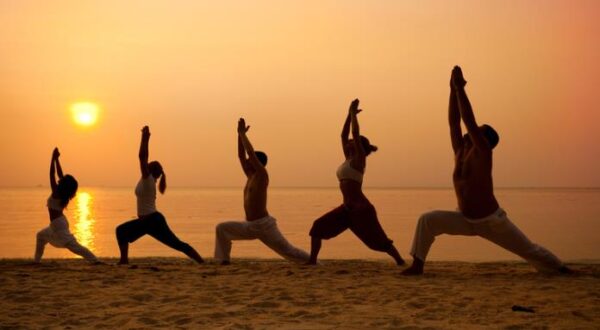In somatic Yoga, movement meets mindfulness in a symphony of healing and self-discovery. In this blog post, we will unravel the mysteries behind Somatic Yoga, exploring its principles, benefits, techniques, and who can benefit most from this innovative practice. So grab your yoga mat and an open mind as we dive into the rejuvenating realm of somatic awareness and inner peace!
What is Somatic Yoga?
Somatic Yoga is a holistic practice that goes beyond traditional yoga asanas, focusing on reprogramming the brain-body connection through mindful movement and awareness. Unlike conventional yoga, which often emphasizes external alignment, somatic yoga delves into internal sensations and movements to release deeply held tension and restore natural mobility. By engaging in slow, intentional movements and gentle exploration of a range of motion, practitioners can unravel patterns of muscular contraction and unlock greater freedom within the body.

This practice encourages individuals to tap into their innate ability to sense and regulate muscle tightness, promoting relaxation and improved function. Through gentle yet powerful movements combined with breathwork, somatic yoga offers a unique approach to cultivating mind-body harmony and releasing physical and emotional stress stored in the body. Embracing this somatic journey can lead to enhanced proprioception, increased flexibility, reduced pain levels, heightened self-awareness, and an overall sense of well-being.
Does Somatic Yoga Work?
Somatic yoga, which focuses on internal body awareness and movement, can be effective for improving flexibility, reducing stress, and enhancing overall well-being. Many practitioners find it beneficial for addressing chronic pain, improving posture, and increasing body awareness. However, its effectiveness may vary depending on individual needs and preferences.
Understanding the Principles of Somatic Yoga
Somatic Yoga is rooted in the principle of somatics, which focuses on the mind-body connection and the awareness of how our bodies move and feel. Unlike traditional yoga that often emphasizes external alignment, Somatic Yoga delves deeper into internal sensations and movements.
The key principles of Somatic Yoga involve slow, gentle movements combined with breath awareness to release tension held in the muscles. By moving mindfully and consciously, practitioners can reprogram habitual movement patterns and alleviate chronic pain or discomfort.
The Benefits of Somatic Yoga Practice
Embarking on a somatic yoga journey offers a myriad of benefits that extend beyond the physical realm. Through gentle movements and mindful awareness, practitioners can tap into deep layers of healing and transformation. Somatic yoga helps release chronic tension stored in the body, promoting relaxation and stress relief.
The practice fosters a profound connection between the mind and body, enhancing overall well-being and emotional balance. By cultivating somatic intelligence, individuals can improve posture, flexibility, and coordination while reducing pain and discomfort.
Somatic yoga empowers practitioners to develop greater self-awareness and mindfulness in their daily lives. This heightened sense of presence allows for increased resilience against life’s challenges.
How Somatic Yoga Works?: Exploring Mind-Body Connection

Somatic yoga works by delving deep into the intrinsic connection between the mind and body. Through gentle movements and mindful awareness, practitioners cultivate a heightened sense of bodily intelligence. This practice encourages individuals to listen to their bodies, tuning into subtle sensations and releasing pent-up tension.
By focusing on internal sensations rather than external alignment, somatic yoga helps rewire neural pathways, promoting relaxation and improved movement patterns. It allows for the release of chronic muscular contractions that may be causing pain or discomfort. As practitioners move through different postures with awareness, they learn to let go of physical and emotional stress stored in the body.
The mind-body connection in Somatic Yoga is a dynamic interplay where thoughts, emotions, and physical sensations are acknowledged without judgment. This holistic approach fosters self-awareness and empowers individuals to tap into their innate healing capacities.
Techniques and Practices in Somatic Yoga
In somatic yoga, the focus is on slow and mindful movements that aim to reprogram the brain-body connection. One common technique used is called “pandiculation,” which involves contracting a muscle and then slowly releasing it while focusing on the sensation. This helps to release chronic muscular tension and improve flexibility.
Another key practice in somatic yoga is sensory-motor training, where practitioners are encouraged to explore different movement patterns with heightened awareness. By tuning into bodily sensations and movements, individuals can enhance their proprioception and kinesthetic intelligence.
Breathwork plays a crucial role in somatic yoga as well. Deep diaphragmatic breathing not only calms the nervous system but also facilitates greater body awareness during movement sequences. This synchronized breath-movement approach promotes relaxation and mindfulness throughout the practice.
Who Can Benefit from Somatic Yoga?
Somatic yoga is a practice that can benefit a wide range of individuals. Whether you are dealing with chronic pain or stress or simply seeking to deepen your mind-body connection, somatic yoga offers something for everyone.
If you struggle with tension in your body from sitting at a desk all day or have tight muscles from physical activities, somatic yoga can help release built-up stress and improve flexibility.

For those looking to enhance their overall well-being and mental clarity, somatic yoga provides a space to cultivate mindfulness and self-awareness through gentle movements and breathwork.
Athletes can also benefit from the practice by improving their body awareness, enhancing performance, and preventing injuries by addressing imbalances and restoring optimal movement patterns.
Regardless of age or fitness level, anyone interested in exploring the profound connection between the mind and body can find value in incorporating Somatic Yoga into their wellness routine.
Precautions and Considerations: Who Should Avoid Somatic Yoga?
Before diving into somatic yoga, it’s essential to be aware of who should approach this practice with caution. While somatic yoga offers numerous benefits, individuals with certain health conditions or physical limitations may need exercise care. If you have any recent injuries or chronic pain issues, it’s advisable to consult with a yoga instructor before starting a somatic yoga practice.
Pregnant women should also be cautious and seek guidance from a qualified instructor experienced in prenatal yoga modifications. Those recovering from surgeries or dealing with severe medical conditions should proceed mindfully and under the supervision of their healthcare provider.
Individuals with specific musculoskeletal disorders or neurological conditions may find that certain somatic yoga movements could exacerbate their symptoms. It’s crucial for anyone considering somatic yoga to listen carefully to their body and honor its signals during practice.
Incorporating Somatic Yoga into Your Wellness Routine
Incorporating somatic yoga into your wellness routine can be a transformative addition to your self-care practices. By engaging in gentle movements and mindful awareness, somatic yoga allows you to tune into the subtle signals of your body and release tension stored within.
Start by setting aside dedicated time each day or week for your somatic yoga practice. Creating a peaceful environment free from distractions can enhance your experience and deepen the mind-body connection.
Listen to your body’s cues during each session, honoring its need for rest or movement as necessary. Allow yourself to explore different postures and techniques with curiosity and openness, embracing the process without judgment.
As you integrate Somatic Yoga into your routine, notice how it influences other areas of your life. You may find increased flexibility, reduced stress levels, improved posture, or a greater sense of inner calm permeating through daily challenges.
Somatic Yoga vs. Traditional Yoga: Key Differences
Somatic yoga and traditional yoga may seem similar on the surface, but they have distinct differences that set them apart. In somatic yoga, the focus is on internal awareness and sensory experience, encouraging practitioners to explore movement patterns and release tension through gentle, mindful movements.
Unlike traditional yoga, which often emphasizes external alignment in poses, somatic yoga prioritizes inner sensations and encourages individuals to move from a place of intuition rather than rigidly following prescribed postures.

Another key difference lies in the approach to relaxation – while traditional yoga incorporates static postures for relaxation, somatic yoga utilizes dynamic movements to release chronic muscle contractions and promote overall body awareness.
Personal Experiences and Testimonials with Somatic Yoga
Somatic yoga has touched the lives of many, offering a pathway to healing and self-discovery. Individuals have shared their heartfelt experiences with this transformative practice.
One practitioner expressed how somatic yoga became a turning point in their battle against chronic upper back pain. Through intentional movements and heightened somatic awareness, they found solace and a newfound connection with their body.
Another testimonial comes from a busy professional who sought refuge in somatic yoga from the daily grind. Each session leaves them revitalized, centered, and equipped to tackle life’s challenges head-on.
Initially hesitant, one individual soon became captivated by the profound impact of somatic yoga on releasing accumulated tension. They marveled at how this practice unveiled hidden stresses within the body, leading to deep relaxation and enhanced well-being.
These personal stories highlight the diverse ways in which somatic yoga can empower individuals on their journey toward holistic wellness and self-care.
Beginners Somatic Stretches
- Seated Spinal Twist
- Begin by sitting comfortably on the floor with your legs extended in front of you.
- Bend your right knee and place your right foot on the outside of your left knee.
- Inhale to lengthen your spine, then exhale and gently twist your torso to the right, placing your left hand on the outside of your right knee and your right hand behind you for support.
- Keep your shoulders relaxed and your gaze soft.
- Hold the twist for a few breaths, then slowly release and repeat on the other side.
- Cat-Cow Stretch
- Start on your hands and knees in a tabletop position, with your wrists directly under your shoulders and your knees under your hips.
- Inhale as you arch your back and lift your chest and tailbone towards the ceiling, coming into a gentle backbend (Cow Pose).
- Exhale as you round your spine, tucking your chin towards your chest and drawing your belly button towards your spine (Cat Pose).
- Flow smoothly between Cat and Cow Pose, coordinating each movement with your breath.
- Repeat for several rounds, allowing your spine to move fluidly and naturally.
- Standing Forward Fold
- Stand with your feet hip-width apart and your knees slightly bent.
- Inhale to lengthen your spine, then exhale as you hinge forward at your hips, folding your torso over your thighs.
- Let your head hang heavy and relax your neck.
- You can bend your knees as much as needed to maintain a comfortable stretch in your hamstrings and lower back.
- Hold the forward fold for a few breaths, feeling a gentle stretch along the back of your legs and spine.
- Supine Figure Four Stretch
- Lie on your back with your knees bent and your feet flat on the floor.
- Cross your right ankle over your left knee, creating a figure four shape with your legs.
- Thread your right hand between your legs and clasp your hands behind your left thigh.
- Gently draw your left thigh towards your chest, feeling a stretch in your right hip and glute.
- Keep your shoulders and neck relaxed as you hold the stretch for a few breaths, then switch sides.
- Child’s Pose
- Start on your hands and knees in a tabletop position.
- Sit back on your heels, bringing your big toes to the touch and spreading your knees wide apart.
- Lower your torso towards the floor, extending your arms out in front of you or resting them alongside your body.
- Rest your forehead on the mat and allow your entire body to relax.
- Take slow, deep breaths as you sink deeper into the pose, feeling a gentle stretch along your spine, hips, and shoulders.
FAQs on Somatic Yoga
1. Is somatic yoga good?
Yes, somatic yoga is beneficial for weight loss, flexibility, tension reduction, and mind-body awareness. It helps alleviate pain, enhance mobility, and foster self-awareness.
2. What is the difference between restorative yoga and somatic yoga?
Restorative yoga focuses on passive stretching and relaxation, with props for deep relaxation. Somatic yoga involves active movements, targeting muscle tension and promoting mindful awareness for improved physical function.

